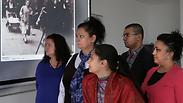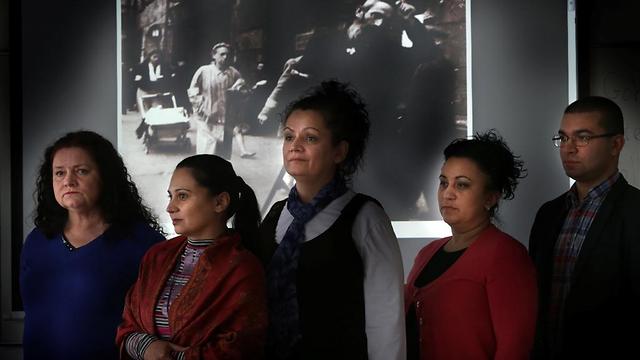
Yellow badge, brown badge: Teaching the persecuted
Eighteen members of Roma community visit Israel to study about Holocaust, learn how to raise awareness to their own genocide
This was the first time that nearly all delegation members, 18 of 20, all teachers, were gypsies from the Roma community.
"The Jews and Romanies had the same fate during the war," says the delegation's leader, Erika Adamová, a former spokesperson for the deputy prime minister of Slovakia who serves today as the chairwoman of the center for the genocide of European Roma.
"In the big ghettos, the Warsaw Ghetto and Łódź Ghetto, where Jews were mainly concentrated, there were also gypsies, as well as in the big concentration camps – Auschwitz, Treblinka, Chełmno and Sobibor. The Nazis destroyed you, and they destroyed us. But unlike us, you have a clear methodology for Holocaust education. We are still at the beginning of the road.
"We want to bring to Yad Vashem more Romani teachers, so that they can get to know the wider picture of the annihilation and gain a better understanding of the Porajmos, as we call the Romani Holocaust."
Romani day of remembrance
The badge worn by the Nazis' victims is another shared symbol. But while almost everyone is familiar with the yellow badge which was used to mark the Jews, few are aware of the gypsies' identification: In some of the territories conquered by the Nazis they were forced to wear a brown badge. In Auschwitz they were given a brown or black triangle with the letter Z – Zigeuner (German for "gypsy").
While it is a known fact that six million Jews were murdered in the Holocaust, the number of Romani deaths is unclear – estimates range from 220,000 to 500,000.
There are many reasons for this uncertainty. Most Romanies did not have certificates or residential addresses and many were murdered in their camps, in the edge of the cities, and their death was never officially documented. Moreover, not many historians researched the Romani genocide, and the Romanies don't have a country to establish institutions like Yad Vashem to commemorate their disaster. Therefore, the delegation members explain, the Romani national narrative is in fact relatively new.
"Every year, on August 2, the day the Nazis destroyed the 'gypsy camp' at Auschwitz-Birkenau, we hold a Romani day of remembrance," says Irena Adamová, who works as a principal in a private high school in the city of Košice, where 60% of students are Romani and which teaches both the Holocaust of the Jews and the Porajmos. "In the latest ceremony, Israel's ambassador said that the Romani Holocaust was a forgotten holocaust. We are here to learn how to bring it back to people's awareness."
Where does the lack of commemoration stem from? "In Slovakia there are monuments in memory of the Jews' Holocaust, but until recently there were no monuments for the Romani Holocaust," adds an English teacher whose maternal grandfather was taken by the Nazis to a concentration camp in 1941 and never returned. "All these years the Slovak governments felt guilty, because Slovaks cooperated with the Nazis."
Ghettos still exist
But the disregard also has to do with the Romani's current situation in Slovakia and in Europe in general. "The situation in Slovakia is extremely difficult," says Erika Adamová. "The radical Right is taking advantage of the economic situation in Europe to gain strength by renewing the old racism, against gypsies and against Jews. We dread the strengthening of the radical, almost neo-Nazi, parties, and that's why we established the European center for Porajmos studies in Košice."
"There is a phenomenon of anti-gypsyism in Europe, like anti-Semitism," adds Irena Adamová. "Like he did for the Jews, Hitler created ghettos for Romanies. But while the Jews' ghettos were taken apart a long time ago, the Romanies' communities have yet to be destroyed. In these ghettos 10 people live in a room, children have no way of preparing their homework or getting ready for exams, which leads to poor achievements in their studies. As a result, children are expelled from elementary schools and placed in special schools for Romanies. It creates social backwardness."
There are some 12 million gypsies living in the world today, quite similar to the number of Jews. Do they envy the Jewish people who have established their own state? "It's difficult for us to think about a state, because we don't know exactly where we're from," Erika Adamová replies. "They say we came to Europe from northern India about 700 years ago, but we don't really know from where."
"We have a commitment to preserve the memory for the future generations, in light of the Romani genocide and the Holocaust of the Jewish people," says Rachel Bad Kaplan, who is in charge of the European Department at the International School of Holocaust Studies. "The seminar participants have joined an international network of thousands of education professionals who are working to guarantee that the memory of the Holocaust will be preserved."











